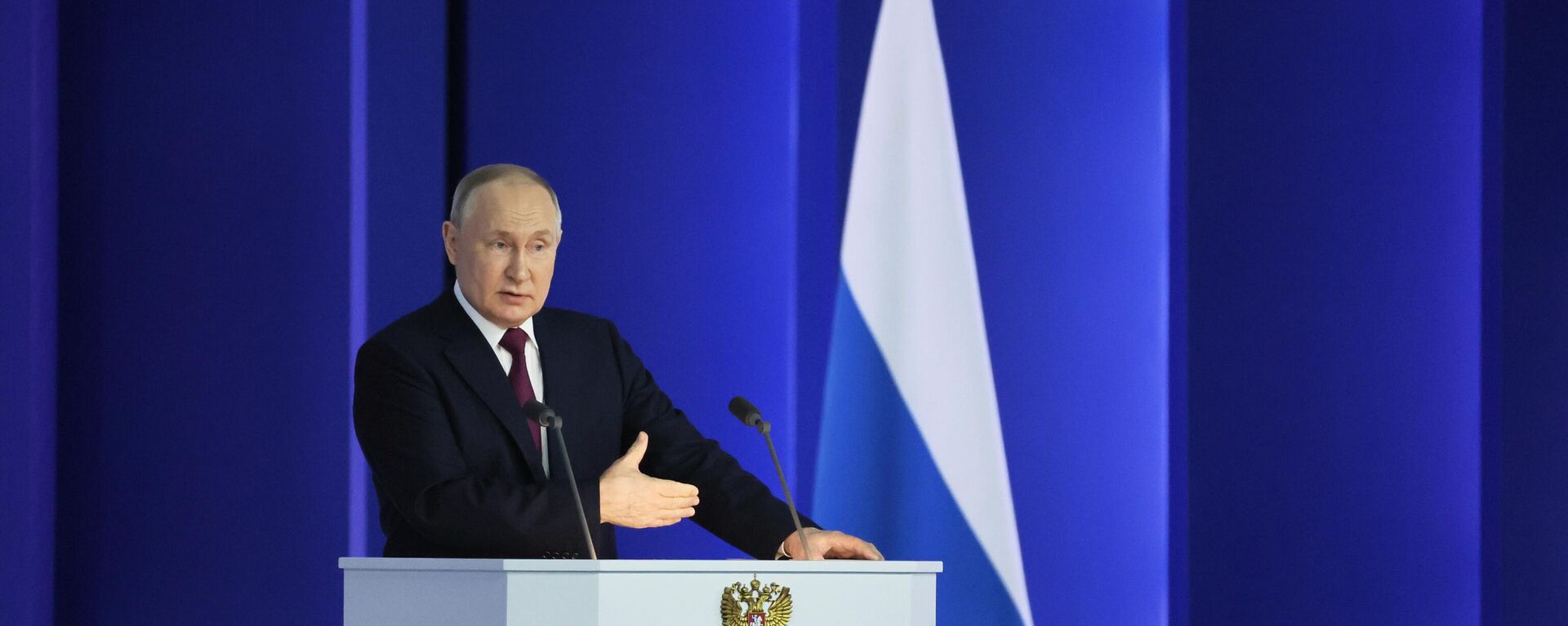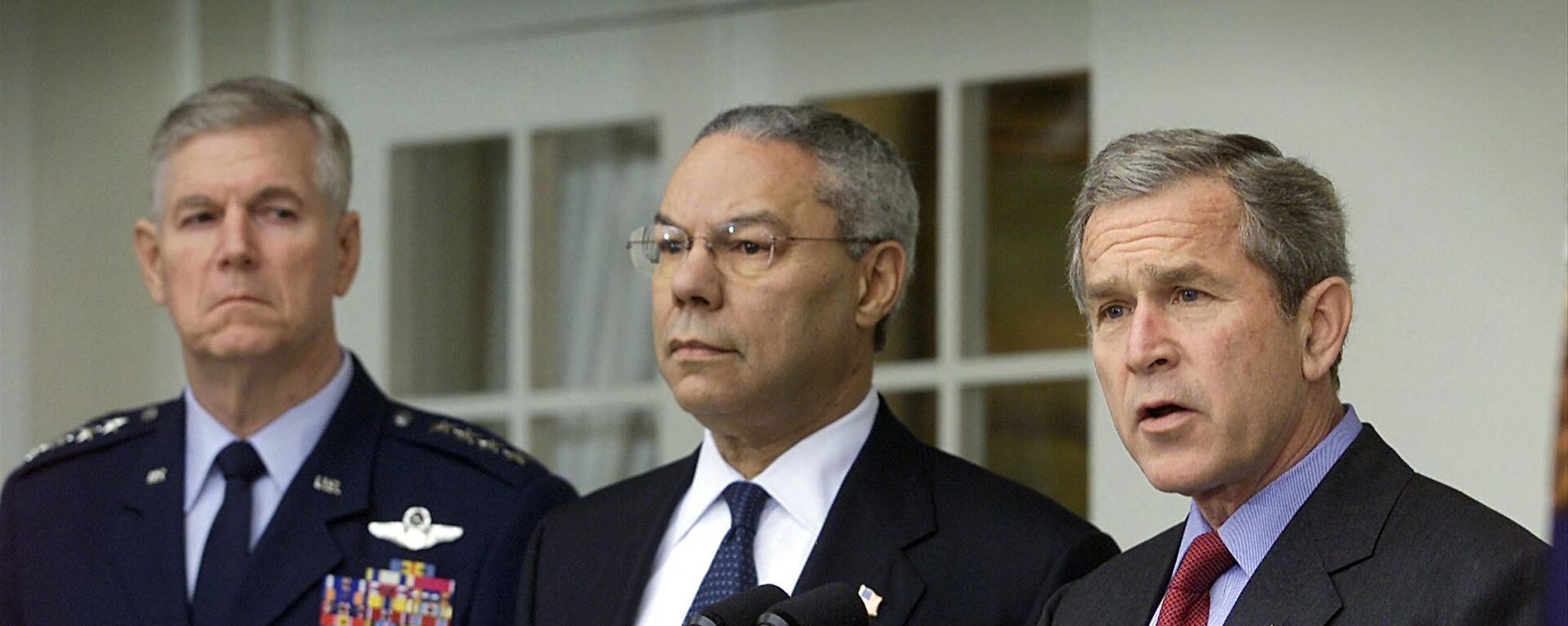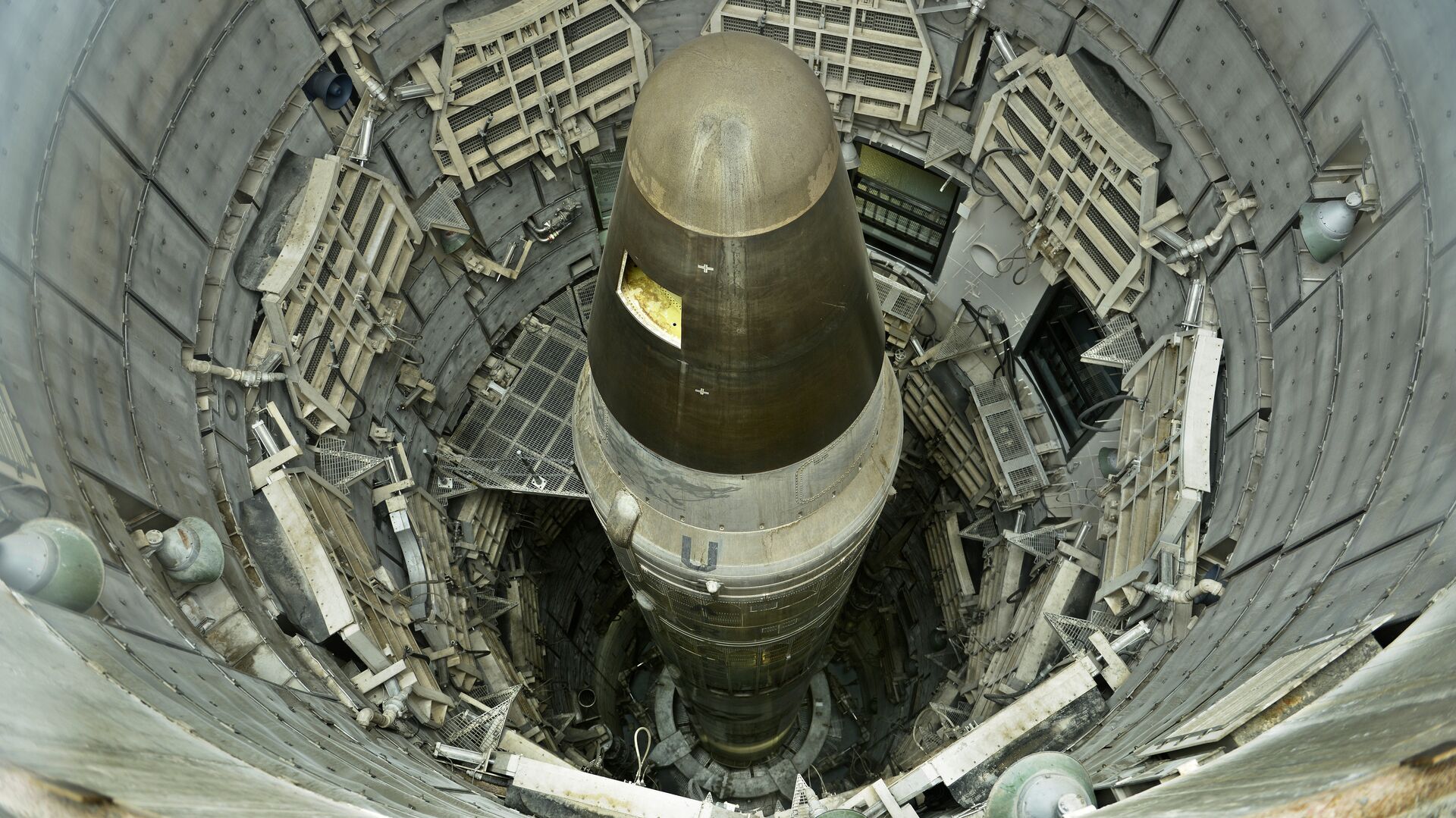https://sputnikglobe.com/20230603/whats-behind-us-new-start-countermeasures-and-whos-poised-to-lose-the-most-1110875137.html
What's Behind US' New START Countermeasures and Who's Poised to Lose the Most?
What's Behind US' New START Countermeasures and Who's Poised to Lose the Most?
Sputnik International
Washington's decision to stop giving Moscow some key information on launches of US intercontinental and submarine-launched ballistic missiles amid NATO's proxy war in Ukraine sends a worrisome signal, Russian military expert Vladislav Shurygin told Sputnik.
2023-06-03T12:27+0000
2023-06-03T12:27+0000
2023-06-03T12:52+0000
analysis
vladimir putin
russia
washington
moscow
nato
sputnik
treaty on open skies
anti-ballistic missile (abm) treaty
new start treaty
https://cdn1.img.sputnikglobe.com/img/105105/69/1051056911_0:237:4500:2768_1920x0_80_0_0_ca3cb76e016aa8ec2260aa13b5d86d17.jpg
The US State Department announced earlier this week that as of June 1 it would withhold notifications required under the new Strategic Arms Reduction Treaty (New START) from Russia.The data it plans to withold includes updates on the status or location of treaty-accountable missiles and launchers, as well as telemetric information on launches of US ICBMs and SLBMs. It also looks to revoke existing visas for Russian New START Treaty inspectors and aircrew members. Why has the US resorted to these measures now?The State Department's fact sheet claimed that the aforementioned "countermeasures" had been adopted in retaliation to Russia's temporary suspension of the New START treaty.How Will Countermeasures Affect Russia and the US?Washington's recent "countermeasures" could have very serious consequences, according to Shurygin.Nonetheless, Russia will not find itself in a more disadvantageous position than the Americans after inspections and sensitive data transferals have been canceled, as per Shurygin."It doesn't give them any advantage," he said. "Moreover, geography in itself, dimension - a feature of our terrain, including mountainous and forested, allows us to very quickly hide our systems, especially mobile missile systems, which are now the basis of our strategic nuclear forces, on the ground. So America will not be able to control them and will not know where they are."Why Did Russia Temporarily Suspend New START Treaty?"We were stopped, first of all, by the fact that America completely evaded compliance with [the New START] treaty, from the fact that it created obstacles in every possible way for the implementation of this treaty," explained Shurygin. "The Americans regularly suspended visas for our inspectors. The Americans regularly blocked our attempts, including those related to the implementation of the open skies agreement on our research trips. And, accordingly, there was also a whole list of everything that did not suit us."New START is a nuclear arms reduction treaty between the US and Russia that came into force on February 5, 2011. It was preceded by: the Treaty of Moscow (SORT) which expired in December 2012; the START I treaty which expired in December 2009; and the START II and START III which never became effective.On February 21, 2023, Russia's President Vladimir Putin announced that Russia was "freezing" its participation in New START. The suspension was signed into law on February 28. However, it did not mean that Russia tore the treaty apart: Moscow made it clear that it would continue to comply with quantitative restrictions on strategic offensive arms and exchange notifications with Washington about ballistic missile launches.During his February speech to the Federal Assembly, Putin explained the rationale behind the move.In sum, the president explained that the aforementioned circumstances forced Russia to temporarily suspend its participation in New START. Still, the Russian president made it crystal clear that Moscow is open to dialogue on the issue.How is New START Dependent on Other US-Russia Treaties?According to Shurygin, various arms treaties between Moscow and Washington, including the Anti-Ballistic Missile Treaty (ABM) of 1972, the Intermediate-Range Nuclear Forces Treaty (INF) of 1987, and START I (Strategic Arms Reduction Treaty) of 1991, de facto constituted a package with the agreements being intertwined. On top of that, in 1992, Moscow and Washington inked the Treaty on Open Skies – a program of unarmed aerial surveillance flights over the entire territory of its participants, which came into effect in 2002.Together, the accords envisaged the reduction of the number of missiles capable of carrying a nuclear load, limited Washington and Moscow's ability to build ballistic missile interceptors, and established mutual surveillance. As a result, the package ensured nuclear parity between the nations and prevented either country from trying to gain an advantage over the other which could upset the global strategic balance.However, after the collapse of the USSR, Washington adopted a triumphalist stance vis-à-vis the Russian Federation and began to snub previous agreements under various pretenses.Bush's pull-out opened the door to the Obama administration's establishment of an Aegis Ashore anti-missile defense complex in Europe, namely in Romania and Poland.Nonetheless, Moscow did not give up: one of the provisions of the New START (2011) specifically stated that Russia reserved the right to withdraw from the treaty if the US missile defense reaches the stage of development when it becomes a threat to Russia's security.However, in 2019, the Trump administration dealt yet another blow to the nuclear strategic parity between Russia and the US by pulling out from the INF. He even tried to twist Russia's hand by threatening to suspend New START. In 2020, Washington likewise withdrew from the Treaty on Open Skies.Little by little, the West has ruined what was seen as an ironclad strategic balance between major nuclear powers established brick by brick during and immediately after the Cold War era.
https://sputnikglobe.com/20230306/npt--new-start-how-us-disrupted-strategic-nuclear-balance-for-the-sake-of-dominance-1108098500.html
https://sputnikglobe.com/20230221/whats-new-start-treaty-and-why-did-russia-suspend-it-1107667839.html
https://sputnikglobe.com/20230221/putins-speech-from-russias-economic-growth--military-advancements-to-new-start-suspension-1107672755.html
https://sputnikglobe.com/20221015/us-designed-european-sky-shield-initiative-to-escalate-tension-with-russia-analyst-says-1101880792.html
https://sputnikglobe.com/20221213/21-years-ago-today-us-rips-up-abm-treaty-with-russia-starting-slow-slide-toward-current-crisis-1105420298.html
russia
washington
moscow
ukraine
Sputnik International
feedback@sputniknews.com
+74956456601
MIA „Rossiya Segodnya“
2023
News
en_EN
Sputnik International
feedback@sputniknews.com
+74956456601
MIA „Rossiya Segodnya“
Sputnik International
feedback@sputniknews.com
+74956456601
MIA „Rossiya Segodnya“
new start treaty, new start suspension, new start countermeasures, inf treaty, what is abm treaty, when bush withdrew from abm treaty, open skies treaty, cold war, global strategic balance, nuclear paritry, west vowed to impose strategic defeat on russia, russian special military operation, us suspension of new start provisions
new start treaty, new start suspension, new start countermeasures, inf treaty, what is abm treaty, when bush withdrew from abm treaty, open skies treaty, cold war, global strategic balance, nuclear paritry, west vowed to impose strategic defeat on russia, russian special military operation, us suspension of new start provisions
What's Behind US' New START Countermeasures and Who's Poised to Lose the Most?
12:27 GMT 03.06.2023 (Updated: 12:52 GMT 03.06.2023) Washington's decision to stop giving Moscow key information regarding intercontinental and submarine-launched ballistic missile launches amid NATO's proxy war in Ukraine sends a worrisome signal, Russian military expert Vladislav Shurygin told Sputnik.
The US State Department
announced earlier this week that as of June 1 it would withhold notifications required under the new Strategic Arms Reduction Treaty (
New START) from Russia.
The data it plans to withold includes updates on the status or location of treaty-accountable missiles and launchers, as well as telemetric information on launches of US ICBMs and SLBMs. It also looks to revoke existing visas for Russian New START Treaty inspectors and aircrew members. Why has the US resorted to these measures now?
"Because America actually started a war against Russia," suggested military expert Vladislav Shurygin. "Now it is waging a proxy war with the hands of the Ukrainians. It tore up all the agreements that were before, and which America did not need: the ABM treaty, the Treaty on Open Skies, and a number of other agreements, which in one way or another made up, in general, a single package. [The US] left for themselves only what is beneficial to them, namely, informing about the state and location of our nuclear missile forces."
The State Department's fact sheet claimed that the aforementioned "countermeasures" had been adopted in retaliation to Russia's temporary suspension of the New START treaty.
How Will Countermeasures Affect Russia and the US?
Washington's recent "countermeasures" could have very serious consequences, according to Shurygin.
After the Americans refuse to provide us with information, they would be left without our information in the same way. This would very sharply increase the level of world instability and danger, because now it would be necessary, at best, to use only direct channels of communication, if one of the parties suddenly misunderstands something or confuses one thing to the other.
Vladislav Shurygin
Military Expert
Nonetheless, Russia will not find itself in a more disadvantageous position than the Americans after inspections and sensitive data transferals have been canceled, as per Shurygin.
"It doesn't give them any advantage," he said. "Moreover, geography in itself, dimension - a feature of our terrain, including mountainous and forested, allows us to very quickly hide our systems, especially mobile missile systems, which are now the basis of our strategic nuclear forces, on the ground. So America will not be able to control them and will not know where they are."
"Of course, for us, too, there will be a problem in this case, with regard to where the American nuclear submarines will be located or where their strategic bombers will be located. We will also have to find this out with the help of our intelligence and our satellites. But, I repeat, for the Americans this is much more of a problem, because they do not have a mobile component of the Strategic Missile Forces, which are powerfully represented [in Russia]. Before that, according to the treaty, it did not cause great concern to the Americans, because it was limited by the treaty to certain compact areas, on which it was all controlled by inspectors. And what's more, they gave out constant information about their location, but now it's all over."

21 February 2023, 14:53 GMT
Why Did Russia Temporarily Suspend New START Treaty?
"We were stopped, first of all, by the fact that America completely evaded compliance with [the New START] treaty, from the fact that it created obstacles in every possible way for the implementation of this treaty," explained Shurygin. "The Americans regularly suspended visas for our inspectors. The Americans regularly blocked our attempts, including those related to the implementation of the open skies agreement on our research trips. And, accordingly, there was also a whole list of everything that did not suit us."
"We have repeatedly appealed to the Americans on this topic, but they have avoided resolving these issues in every possible way," continued the military expert. "And accordingly, in this case, they simply used only that part of the agreement that was beneficial for them, namely, obtaining strategic information about the position of our strategic nuclear forces, respectively, about their movements, about any launches, tests, and others. In fact, they interpreted it and used it unambiguously in their own interests. This, of course, did not suit us. We warned, and given how aggravated the situation was, we just got out of it."
New START is a nuclear arms reduction treaty between the US and Russia that came into force on February 5, 2011. It was preceded by: the Treaty of Moscow (SORT) which expired in December 2012; the START I treaty which expired in December 2009; and the START II and START III which never became effective.
On February 21, 2023, Russia's President Vladimir Putin announced that Russia was "freezing" its participation in New START. The
suspension was signed into law on February 28. However, it did not mean that Russia tore the treaty apart: Moscow made it clear that it would continue to comply with quantitative restrictions on strategic offensive arms and exchange notifications with Washington about ballistic missile launches.
During his February speech to the Federal Assembly, Putin explained the rationale behind the move.
First, he cited Washington's attempts to
overhaul the post-WW2 world order, agreed by major allied powers in Yalta in February 1945.
Second, the Russian president referred to the US' unilateral withdrawals from milestone strategic weapons treaties;
NATO's enlargement towards Russia's borders starting in late 1990s in clear violation of previous verbal agreements; as well as the deployment of massive
ballistic missile installations in Europe under the guise of an illusionary "nuclear threat" from Iran.
Third, Putin pointed to the fact that the principle of reciprocity when it came to mutual inspections of nuclear sites under New START was not fully observed by the US.
Fourth, the Russian president raised the question as to why NATO's two other nuclear-armed powers, the UK and France, have never been bound by New START.
Fifth, Putin expressed deep concerns over the West's pledge to
impose a strategic defeat on Russia, bleed it white and make it incapable of waging active military actions amid the ongoing special military operation in Ukraine.
In sum, the president explained that the aforementioned circumstances forced Russia to temporarily suspend its participation in New START. Still, the Russian president made it crystal clear that Moscow is open to dialogue on the issue.

21 February 2023, 17:29 GMT
How is New START Dependent on Other US-Russia Treaties?
According to Shurygin, various arms treaties between Moscow and Washington, including the Anti-Ballistic Missile Treaty (ABM) of 1972, the Intermediate-Range Nuclear Forces Treaty (INF) of 1987, and START I (Strategic Arms Reduction Treaty) of 1991, de facto constituted a package with the agreements being intertwined.
On top of that, in 1992, Moscow and Washington inked the Treaty on Open Skies – a program of unarmed aerial surveillance flights over the entire territory of its participants, which came into effect in 2002.
Together, the accords envisaged the reduction of the number of missiles capable of carrying a nuclear load, limited Washington and Moscow's ability to build ballistic missile interceptors, and established mutual surveillance. As a result, the package ensured nuclear parity between the nations and prevented either country from trying to gain an advantage over the other which could upset
the global strategic balance.

15 October 2022, 13:57 GMT
However, after the collapse of the USSR, Washington adopted a triumphalist stance vis-à-vis the Russian Federation and began to snub previous agreements under various pretenses.
For its part, Moscow sought to preserve the balance. Thus, Russian lawmakers tried to make START II (January 3, 1993) conditional on maintaining the ABM Treaty which restrained the deployment of strategic defensive armaments. However, US lawmakers refused to ratify the Extension Protocol and the 1997 ABM Demarcation Agreements, while in 2002 US President George W. Bush unilaterally tore the ABM treaty apart.

13 December 2022, 13:36 GMT
Bush's pull-out opened the door to the Obama administration's establishment of an Aegis Ashore anti-missile defense complex in Europe, namely in Romania and Poland.
Nonetheless, Moscow did not give up: one of the provisions of the New START (2011) specifically stated that Russia reserved the right to withdraw from the treaty if the US missile defense reaches the stage of development when it becomes a threat to Russia's security.
However, in 2019, the Trump administration dealt yet another blow to the nuclear strategic parity between Russia and the US by pulling out from the INF. He even tried to twist Russia's hand by threatening to suspend New START. In 2020, Washington likewise withdrew from the Treaty on Open Skies.
Little by little, the West has ruined what was seen as an ironclad strategic balance between major nuclear powers established brick by brick during and immediately after the Cold War era.







